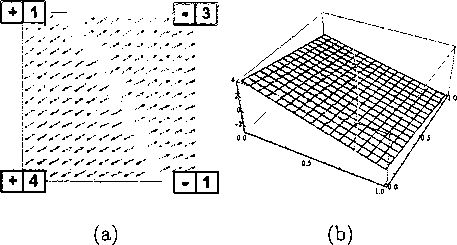11

Figure 2.1 : Two material example. 2.1(a) shows the bilinear function of a single cell.
Red represents the parts of the cell that has positive values in the bilinear evaluation,
and green represents the negative values. The arrows indicate the direction of the
gradient. 2.1(b) is the plot of the bilinear function in 3D with the same color
representation.
• Return the material index к for which tk(x) is maximum.
This classification method has several important properties. The first property is
that the classification method reproduces the contours produced by standard +/—
contouring. Given a signed set of scalars si, the associated tri-linear interpolant s(x)
is either positive or negative. According to our material classification method, the
coefficients si can be partitioned in a two sets of non-negative coefficients it+ and t~.
Note that these coefficient sets satisfy the relation
sl = t↑-t- (2.1)
Therefore, the associated tri-linear functions t+(τ) and t~(x) also satisfy
s(τ) = t+(x) — t~(x). (2.2)
It follows that the function s(æ) is positive if t+(x) is larger than t~(x) and negative
if t~(x') is larger than t+(x), agreeing with the result computed by our classification
algorithm.
Figure 2.1 illustrates the standard bi-linear approach to contouring in 2D. Fig-
ure 2.1(a) shows a single cell whose corners have attached signed scalar values. Fig-
More intriguing information
1. A parametric approach to the estimation of cointegration vectors in panel data2. Two-Part Tax Controls for Forest Density and Rotation Time
3. Income Mobility of Owners of Small Businesses when Boundaries between Occupations are Vague
4. The storage and use of newborn babies’ blood spot cards: a public consultation
5. NATURAL RESOURCE SUPPLY CONSTRAINTS AND REGIONAL ECONOMIC ANALYSIS: A COMPUTABLE GENERAL EQUILIBRIUM APPROACH
6. Perfect Regular Equilibrium
7. The name is absent
8. The name is absent
9. Cross-Country Evidence on the Link between the Level of Infrastructure and Capital Inflows
10. Improving behaviour classification consistency: a technique from biological taxonomy